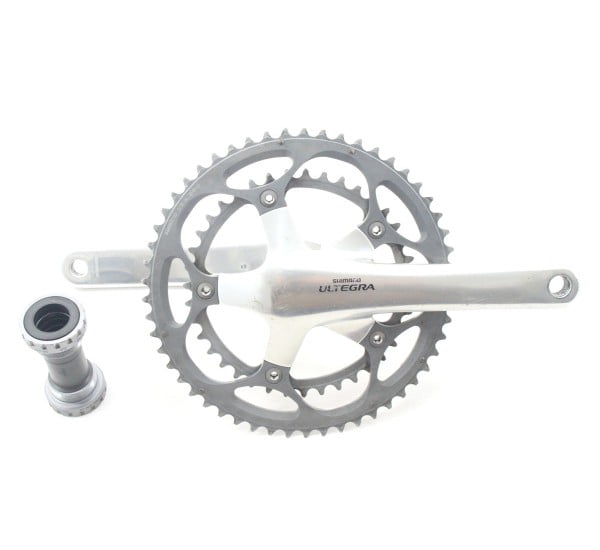Those into cycling must have heard, or read something like: “The bike comes with a full Ultegra groupset”. Or: “Fully Shimano Deore equipped bicycle”. This post will explain what a “bicycle groupset” is, what parts it consists of. Other, less common name for a bicycle groupset is “bicycle equipment”.
1. What is a bicycle groupset
Bicycle consists of three major part groups:
- Frame (with saddle, handlebars, racks, mudguards – all the parts attached that are immobile practically, apart from rotating fork).
- Wheels
- Groupset, or “equipment”
Groupset is a sum of parts that make bicycles transmission, gearing and braking. This usually consists of front chainrings, crankset, chain, rear sprockets, brakes, brake and shifter levers, derailleurs. Wheel hubs are sometimes included as well, though the strict use of the term excludes the hubs.
For a list of groupsets classes by various manufacturers, from cheapest to top class, with recommendations for the optimal choice depending on one’s use, see: Bicyle equipment (“groupset”) classess.
2. What does a groupset consist of – parts
Here is an explanation of each separate part that makes a groupset, or bicycle’s equipment. Detailed explanation of types and attributes of various models for each part requires a separate post, some other time. First a list of all the parts:
2.1. Cranks (“crankset”)
Consists of bearings (called bottom bracket, or BB), axle, crank arms, on which pedals and chainrings are attached. Technically correct term is “crank”, or “cranks”, but this is not the only situation where both cyclists and bicycle mechanics use incorrect terms. So, when in Rome… 🙂

This type has axle attached directly to the crank arms, going through the bearings.
Detailed explanation of BB types in a separate post.
Crankset is used to propel the bicycle. Pedals are pushed, through crank arms they turn the chainrings, which move the chain, making the bicycle “drive” forward. Good crankset should have stiff cranks, good quality BB and strong chainrings.
2.2. Cassette – “rear sprocket”
Cassette is a set of rear chainrings. If there is only one, it is reffered to as: “(rear) sprocket”. Technically correct term is “chainring”, not “sprocket”, but the latter one is commonly used in “bicyclese language”. They come in various number of clusters, and various ranges of teeth. Expensive ones are usually lighter, some might last a bit less – the extra expensive light ones that aren’t made of steel.

Posts on this topic: Speeds – rear sprockets
Rear sprockets – freewheel vs cassette
2.3. Chain

It should match the number of rear sprockets. More expensive ones are stronger and last longer (it rhymes 🙂 ), up to a point. Above a certain price point, one pays just for the lower weight.
2.4. Derailleurs
Used for changing gear ratios. They move chain from one sprocket to the other. Except if the bicycle has gears inside the rear hub, in which case chain is not moved to change gear ratios (explained here: Bicycle internal gear hub). Good ones enable changing gears in harsh conditions (bumps, mud, inexperienced rider who tries to change gears while pedalling hard).
Posts on derailleurs: Front derailleur
Rear derailleur
2.5. Shifters
Handles used to control derailleurs. Sometimes they are integrated with brake handles, sometimes separate. Two basic types are:
friction shifters – analogue. Rider pulls the handle until a gear is changed.

indexed shifters – practically digital. One click for one shift. Either by pressing buttons, or moving a handle and hearing/feeling it click.



Good quality ones usually last a bit longer and work more reliably – changing gears more precisely if they are indexed. Friction shifters are practically indestructible and good quality metal friction shifters can last for decades. Detailed explanation of the difference between indexed and friction shifters.
Trim option: some modern front shifters have a trim, or a trimming option. This is some sort of mid-position. The gear is not changed, but the front derailleur cage is moved just a little so that chain rub is eliminated when the chain is moved sideways at the rear (see here the paragraph Chain line and cross chaining).
2.6. Brake levers
Used to control brakes. Good ones are usually made of aluminium, or steel, while the cheap poor ones are usually plastic. They should match the type of brakes used. Two major groups are:
a) hydraulic
b) cable actuated brakes
Cable actuated brakes are divided to several types (disc, V-brake, cantilever etc.). Full list and explanation of mechanical bicycle brake types.
Apart from brake levers integrated with shifters (shown in the photos above), there are also separate brake levers, shown in the pictures below:


2.7. Brakes
Used for controlled slowing down of wheel turning speed. Good quality brakes should have these two attributes:
a) strong stopping power: making it possible to brake hard.
b) good control (dosage) of braking power: to avoid braking weaker than intended, or accidentally, without wanting, lock a wheel and cause it to slide.



3. Combining
All these parts can be mixed and matched to create an optimal bicycle for one’s needs. Taking price, weight and planned use into account, everyone can choose for themselves what is the best combination for them. Type of bicycle frame also influences the choice of equipment – mostly brake choice available.
4. Compatibility
It is important to know what equipment is compatible with each other. Sometimes parts from various manufacturers can be mixed, while sometimes parts of the same manufacturer are not compatible with each other. Details of what can be mixed with what are explained in separate articles, here: Compatibility.
Groupset (equipment) classes and quality variations are explained in the post Bicyle equipment (“groupset”) classess:


